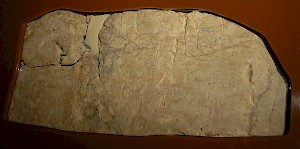The Siloam Inscription
Siloam Inscription: inscription from Jerusalem, now in the Istanbul Archaeological Museum, documenting the cutting of a water tunnel.

After the Assyrian capture of Samaria, in 724 or 722 BCE, refugees from Israel came to the south, to Judah. Its capital Jerusalem was expanded to the west. Recognizing that the city would one day be the target of renewed Assyrian aggression, the Jewish king Hezekiah (r. 715-687) prepared Jerusalem for a siege. The Gihon spring, situated in the Kidron valley east of the city, was hidden from sight, while a 533 meter long tunnel was cut (along a natural fissure) to make the waters flow into the city, to the pool of Siloam (or Shiloach). It was an impressive work, which even the author of 2 Kings, who was not really interested in worldy matters, could not ignore:
Everything else Hezekiah did while he was king, including how he made the upper pool and tunnel to bring water into Jerusalem, is written in The History of the Kings of Judah.note
In the tunnel was a brief inscription, written in an old type of the Hebrew alphabeth (palaeographically dated to the late eighth or seventh century), of the first meeting, deep underground, of two teams of workers.
... [when the tunnel] was driven through. And this was the way in which it was cut through:
While [the quarrymen were] still [...] axes, each man toward his fellow, and while there were still three cubits to be cut through, [there was heard] the voice of a man calling to his fellow, for there was an overlap in the rock on the right [and on the left]. And when the tunnel was driven through, the quarrymen hewed [the rock], each man towards his fellow, axe against axe; and the water flowed from the spring toward the reservoir for 1,200 cubits, and the height of the rock above the heads of the quarrymen was a hundred cubits.note
In 701, the Assyrian king Sennacherib laid siege to Jerusalem, but was unable to capture the capital of Judah.